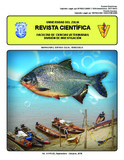| dc.rights.license | http://creativecommons.org/licenses/by-nc-sa/3.0/ve/ | es_VE |
| dc.contributor.author | Chileski, Gabriela Soledad | |
| dc.contributor.author | Rios, Elvio Eduardo | |
| dc.contributor.author | Lértora, Walter Javier | |
| dc.contributor.author | Gimeno, Eduardo Juan | |
| dc.contributor.author | Cholich, Luciana Andrea | |
| dc.date.accessioned | 2019-10-30T15:01:54Z | |
| dc.date.available | 2019-10-30T15:01:54Z | |
| dc.date.issued | 2019 | |
| dc.identifier.issn | 0798-2259 | |
| dc.identifier.uri | http://www.saber.ula.ve/handle/123456789/46142 | |
| dc.description.abstract | Senna occidentalis es una planta tóxica que afecta a diferentes
especies de animales. La lesión hallada en la mayoría de los animales intoxicados es la degeneración muscular. Sin embargo, la encefalopatía hepática (EH) es observada en equinos y en humanos. El objetivo de este trabajo fue determinar si, además de la miodegeneración ya reportada, semillas y vainas de S. occidentalis inducen una EH tóxica en cerdos. Diez animales se dividieron en dos grupos (de cinco animales cada uno), un grupo se alimentó con una ración que contenía el 20% de vainas y semillas de S. occidentalis, y los animales controles recibieron ración comercial durante 14 días. Los animales intoxicados presentaron síntomas de aparición brusca, caracterizados por incoordinación, ataxia, desorientación, presión de la cabeza contra objetos duros, depresión y recumbencia lateral. La aspartato aminotransferasa y creatinquinasa incrementaron junto a la Bilirrubina Total en los animales intoxicados. La evaluación histopatológica de los cerdos alimentados con S. occidentalis evidenció tumefacción hepatocelular y necrosis centrolobulillar en el hígado; mientras que el encéfalo presentó vacuolización de la sustancia blanca y astrocitos Alzheimer tipo II en la corteza cerebral. La microscopía electrónica reveló lesiones mitocondriales en el hígado. Estos resultados muestran que en el presente estudio, la lesión muscular ya reportada no se observó, seguramente debido a que la EH tóxica reproducida en los animales evaluados se produjo antes de que ello ocurra. Por otro lado, los animales del presente estudio desarrollaron signos clínicos y lesiones histológicas que fueron similares a esas observadas en casos de envenenamiento accidental. Además futuros estudios son necesarios para identificar el tóxico responsable de la falla hepática aguda, observada en los animales de este estudio. | es_VE |
| dc.language.iso | es | es_VE |
| dc.publisher | SaberULA | es_VE |
| dc.rights | info:eu-repo/semantics/openAccess | es_VE |
| dc.subject | Encefalopatía hepática | es_VE |
| dc.subject | Cerdos | es_VE |
| dc.subject | Intoxicación | es_VE |
| dc.subject | Planta tóxica | es_VE |
| dc.title | Hepatic encephalopathy induced by seeds and pods of Senna occidentalis in pigs | es_VE |
| dc.title.alternative | Encefalopatía hepática inducida en cerdos por semillas y vainas de Senna occidentalis | es_VE |
| dc.type | info:eu-repo/semantics/article | es_VE |
| dcterms.dateAccepted | 19/01/2018 | |
| dcterms.dateSubmitted | 10/10/2018 | |
| dc.description.abstract1 | Senna occidentalis is a toxic plant that affects different animal species. The predominant lesion found in most of the intoxicated animals is skeletal muscle degeneration. However, in horses and humans, this poisoning is primarily characterized by hepatic encephalopathy (HE). The aim of this paper was to determine whether, in addition to this myodegeneration, the seeds and pods of S. occidentalis induce toxic EH in pigs. Ten pigs were divided into two groups (of five animals each), one of which were fed with a ration containing 20 % of S. occidentalis pods and seeds, and the other with a commercial ration (control) for 14 days. Poisoned animals had a sudden onset of symptoms, characterized by incoordination, ataxia, disorientation and head pressing, depression and lateral recumbency. Aspartate aminotransferase and Creatine phosphokinase serum activities increased along with an increasement of serum bilirubin in intoxicated animals with S. occidentalis. Histopathological studies of the poisoned pigs showed hepatocellular swelling and centrilobular necrosis in the liver, vacuolization of the white matter and Alzheimer type II astrocytes in the cerebral cortex of the brain. Electron microscopy revealed mitochondrial lesions in liver. These results showed that in this study, the muscle injury previously reported was not observed, most probably because the toxic EH reproduced in the evaluated animals were produced before skeletal muscle degeneration occurred. On the other hand, the animals of the present study developed clinical signs and histological lesions that were similar to those observed in cases of accidental poisoning. Besides, further studies are needed to identify the specific toxin responsible for acute liver failure, observed in the animals of this study. | es_VE |
| dc.description.colacion | 343-348 | es_VE |
| dc.description.email | lucianaandreacholich@gmail.com | es_VE |
| dc.identifier.depositolegal | pp199102ZU46 | |
| dc.identifier.edepositolegal | ppi201502ZU4665 | |
| dc.identifier.eissn | 2477-944X | |
| dc.publisher.pais | Venezuela | es_VE |
| dc.subject.institucion | Universidad del Zulia (LUZ) | es_VE |
| dc.subject.institucion | Universidad de Los Andes (ULA) | es_VE |
| dc.subject.keywords | Hepatic encephalopathy | es_VE |
| dc.subject.keywords | Pig | es_VE |
| dc.subject.keywords | Poisoning | es_VE |
| dc.subject.keywords | Toxic plant | es_VE |
| dc.subject.publicacionelectronica | Revista Científica | |
| dc.subject.thematiccategory | Medio Ambiente | es_VE |
| dc.subject.tipo | Revistas | es_VE |
| dc.type.media | Texto | es_VE |


